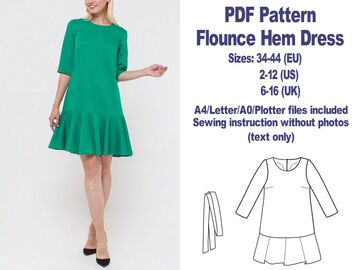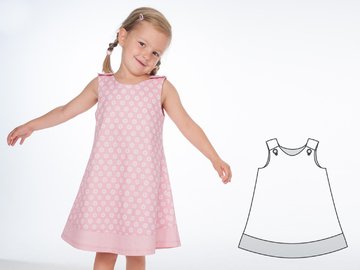Especially with a new quilt project, sometimes there are jobs that I don't enjoy as much as other jobs. These include sewing jobs that involve sewing the same type of fabric pieces together umpteen times.
For example, I once had a quilt where about 100 triangles were sewn together. Sewing two triangles together at a time, then the next pair, etc.... I confess, the fun didn't start for me until after I had sewn the pairs and could then work them further. Maybe you feel the same way?
Then I have a wonderful technique for you: chain sewing!
This technique is very time-saving, because you first prepare the fabric parts optimally and then sew many parts at once one after the other.
But let's start from the beginning:
Preparation of the fabric parts
You cut the fabric pieces for your patchwork pattern, your patchwork block.
Then you lay out the fabric pieces on your table as the later pattern should look like.
In my example, it is a so-called block of nine. The block is called the rest 54-40 or Fight. This is a very old, traditional patchwork pattern. I am currently writing the book for this block. So it will be a little while before I can offer you these instructions. 😉
In a block of nine, there are three squares in a row. There are three rows in this block. Three times three patches makes a total of nine patches. So the name nine block comes from the number of squares, the patches.
However, depending on the complexity of the block, the individual squares are again divided into smaller patches. In my block, you can see that some squares are divided into three triangles. It's these possibilities that make the various patterns so interesting.
You place 2 pieces of fabric on top of each other to be sewn together. The right, nice side of the fabrics is on the inside.
In the nine-patch block, you first sew two fabric pieces together at a time, and then later you sew the third fabric piece of the respective row to the two patches sewn first.
So for the two pieces of fabric that are to be sewn together, the right, beautiful side of the fabrics is on the inside. The side that will be sewn is on the right. So the fabric pieces lie exactly as if you are going to grab them to sew right away.
You put these fabric pieces near your sewing machine so you can grab them right away when you sew the chain.
Now I'll give you a tip for the optimal presser foot and we can start sewing.
The optimal presser foot for chain piecing
You use a presser foot that matches the seam allowance of your fabric pieces.
This means:
Is your patchwork pattern written metrically, i.e. with centimeter specifications? Do your fabric pieces contain the metric seam allowance of 0.75 centimeters, which is standard in Germany?
Then you are using a presser foot that matches this seam allowance. Maybe you have a presser foot that has an edge on the right, so that when you sew your fabric piece, it butts up against that edge on the right? Great! Then use one of those. Please check again if the seam allowance is really 0.75cm with this presser foot.
Is your patchwork pattern imperial, i.e. written with inches? Then your fabric pieces contain the imperial seam allowance of ¼ inch, which is very common in patchwork, i.e. 0.25 inch?
For this seam allowance of ¼ inch, there are special patchwork presser feet that have the edge described above on the right. I find these patchwork presser feet very useful. Please also check if the seam allowance is really 0.25 inch for this presser foot.
If the seam allowance is not exact on your presser foot, then maybe you can move the needle a little to the left or right on your sewing machine? Modern sewing machines often have this feature. Then see if you can move the needle accordingly and it works optimally with this presser foot.
If you only have a "normal" presser foot, then of course you use this one.
I sewed the first years with a very old and simple sewing machine. It also works very well with simple sewing machines. You just pay more attention that you sew with the appropriate seam allowance. That is then just real handwork 😉
What is chain piecing?
When sewing chains, several pieces of fabric are sewn one after the other.
This is especially time-saving if you are sewing a quilt where you can pre-sort many individual pieces and sew them all at once.
So, for example, because your patchwork quilt consists of several blocks.
For example, depending on the size of a single block, a quilt may consist of five rows of 7 blocks each. That would be 35 blocks that need to be sewn.
Any other variation of rows and blocks is possible, of course.
I want to demonstrate to you with this example that it can be very useful if you can sew many patches in one sweep.
You now have your patches together and they are near your sewing machine.
Now you put the first pieces of fabric that will be sewn together to the presser foot and sew the two pieces of fabric together.
The patchwork foot with the edge will help you sew with the correct seam allowance.
Will the seams be locked or not?
Bartacking a seam means sewing one to two stitches forward and backward at the beginning and end of a seam. This secures the beginning and end of the seam so that this seam will not open.
I also lock the seams of the respective patches when sewing the chain. But you can also find statements in books and on the Internet that this is not necessary.
As always in patchwork, each may choose how he or she prefers to work. So please sew the way you like it.
Here, on this presser foot, you can see how the edge of the fabric rests against the edge of the presser foot. This makes it much easier to always sew at the same distance.
If you keep this in mind with each piece of fabric, your patches will all have the same, correct seam allowance.
So you're sewing the first (double layered) piece of fabric together.
When the first piece is sewn together, then you sew a few stitches into the blank. This means that your sewing machine sews a few stitches without any fabric under the presser foot.
Then place the next prepared piece of fabric under the presser foot at the front.
After the stitches into the void, the transporter of your sewing machine will push the new piece of fabric under the presser foot and the new piece of fabric will be sewn.
If your presser foot does not grip the piece of fabric so well, you can also lift the presser foot and place the new piece of fabric under the presser foot at the front. Then the transporter pulls the fabric piece under the presser foot and sews the pieces together.
With this technique, it is important that there is always a small piece of thread between the sewn fabric pieces.
So the thread is not cut between the respective pieces of fabric.
I prefer to use a patchwork foot for my patchwork projects. Because of the edge on the presser foot, the fabric holds onto that edge relatively independently.
I find this very handy because it is easy to move the fabric back and forth too much, causing it to be too far to the left or right of the edge of the presser foot.
If you don't like this sewing into the void, you can also pull the fabric part back a little after sewing. The disadvantage is that you have to lift the presser foot after each piece of fabric. Try it out, both techniques are possible here.
When you have sewn all the prepared fabric pieces together, you will see why this technique is called "chain piecing". The fabric pieces are now lined up next to each other like a pennant chain.
There is always a small space between the fabric pieces. In this space you can see the sewing thread, these are the stitches that you sewed into the empty space before.
Cut the individual pieces of fabric apart at these exact points. You now have a small piece of sewing thread at the beginning and at the end of each piece of fabric, so that the seam does not open up again.
Now open the sewn pieces of fabric and smooth them with your fingers. Then you can lay out your block pattern again and sew the next pieces together.
Here you can see how the just sewn patches look in my pattern.
I hope you have fun with your new chain piecing technique and sewing your new quilt!
If you feel like it, check out my other blog posts here on cp. There you will find more tips and tricks on patchwork and quilting.
Happy stitching!
Chris
.JPG)
.JPG)
.JPG)
.JPG)
.JPG)
.JPG)
.JPG)
.JPG)
.JPG)
.JPG)
.JPG)
.JPG)
.JPG)
.JPG)




























































































































































